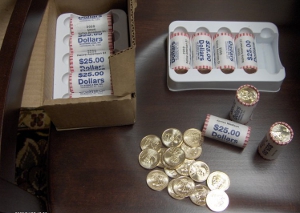

U.S. Mint Says Public Embracing Dollar Coin

U.S. Mint Press Release:
""The initial public demand for the Golden Dollar has been extraordinarily strong,"" said [the Mint Director], "and it is clear that this enthusiasm is fueling demand from banks and retailers. We are hearing from many banks and retailers who have not ordered ... dollars in years, if ever. As a result, we have a backlog of orders we will be filling over the next several weeks. We are working closely with the Federal Reserve to expedite shipments to banks, and we are rapidly increasing production of Golden Dollars."
"Especially gratifying," the [Mint Director] continued, "is what we are hearing from the American people. They are telling us the coins are beautiful ... it is clear that we have exceeded all expectations for the coin's acceptance by the public."
Sounds like the new Presidential dollar series is a winner, doesn't it? The accolades can't get much better than this. So has the new Presidential dollar series really been accepted by the public?
Umm, I have a little secret to tell you. . . . The U.S. Mint press release above was actually released in February 2000. It is announcing the overwhelming success of the new Sacagawea dollar. You know, that dollar coin we all use now in place of the dollar bill. [Yes, that's sarcasm]
So just how successful was the Sacagawea . . . really?
Well just by emptying our pockets and looking at our change tells you how well it did at replacing the dollar bill. I have one in my pocket that I got in change from a vending machine. But it's been in my pocket for years. It's not doing much circulating. Recently it was joined by a Washington dollar that I also got from a vending machine.
But was the Sacagawea program really a success?
There were 1.2 billion dollar coins minted in 2000 versus a mere 40 million in 1999. With a cost of around 12 cents per coin to mint, that translated to an increase in the Mint's gross profit for the dollar coin from about $35,200,000 to a gross profit of around $1,056,000,000 - an increase of 3000%.
A billion dollar increase in your profit; I'd say that was a success. But within just a couple of years, annual dollar production dropped to about $7 million and has headed downwards ever since.
So what about the new Presidential dollars?
I believe that there were less than $5 million of Sacagawea dollars minted in 2006. If all four Presidential dollars - Washington, Adams, Jefferson, and Madison - are minted in quantities of $300 million dollars each as currently planned, that would be $1.2 billion dollars, just shy of the Sacagawea total in 2000. But wait . . . with the law stating that at least one-third of the total dollar production must be the Sacagawea dollar each year, that's another $600 million dollars for a 2007 total of $1.8 billion dollars - an increase of 36,000% over 2006!

Now I'm sure the cost of producing the dollar is more than the 12 cents of seven years ago, but it's also not close to being a money loser like the cent or nickel. The fact that they will be issuing four new Presidential coins a year and with all the Washington error coins generating interest, they should be able to keep the total mintage figures in the years ahead much higher than the dwindling Sacagawea number of the past few years.
So I would say from Congress's point of view, it sure seems to be a success. If somehow the public actually did accept the dollar coin over the dollar bill, then that would keep the mintage totals even higher each year and the profit that much better. That would also require a more controversial decision by Congress to do away with the dollar bill, which in itself, would be a savings. But Congress usually takes the easy way out, so I don't see that happening anytime soon.
So if they haven't said it already about the Presidential dollars, I'm sure we will hear this soon:
"Especially gratifying, is what we are hearing from the American people. They are telling us the coins are beautiful ... it is clear that we have exceeded all expectations for the coin's acceptance by the public."